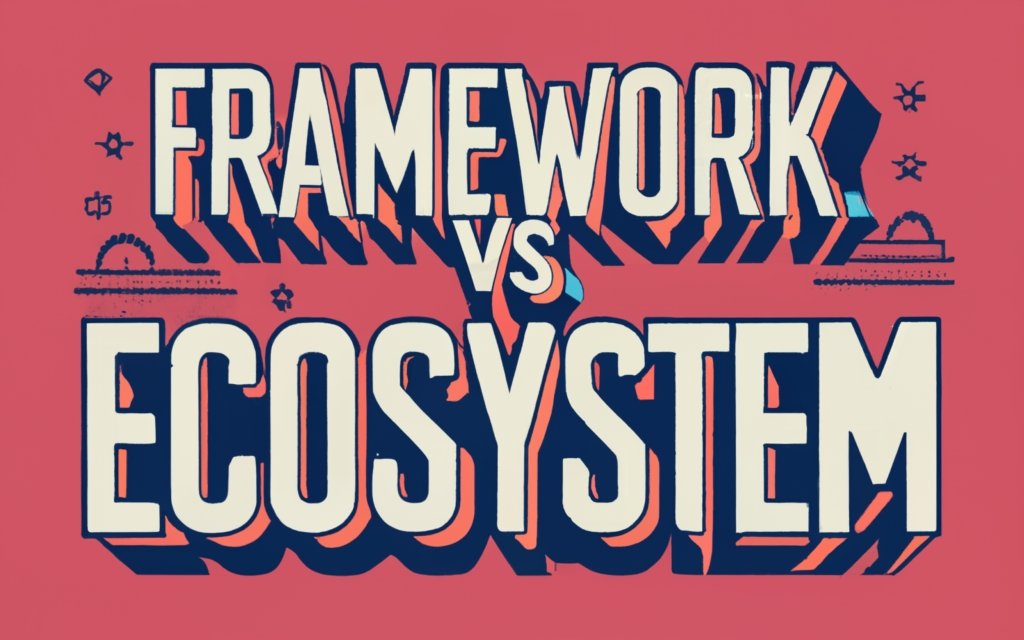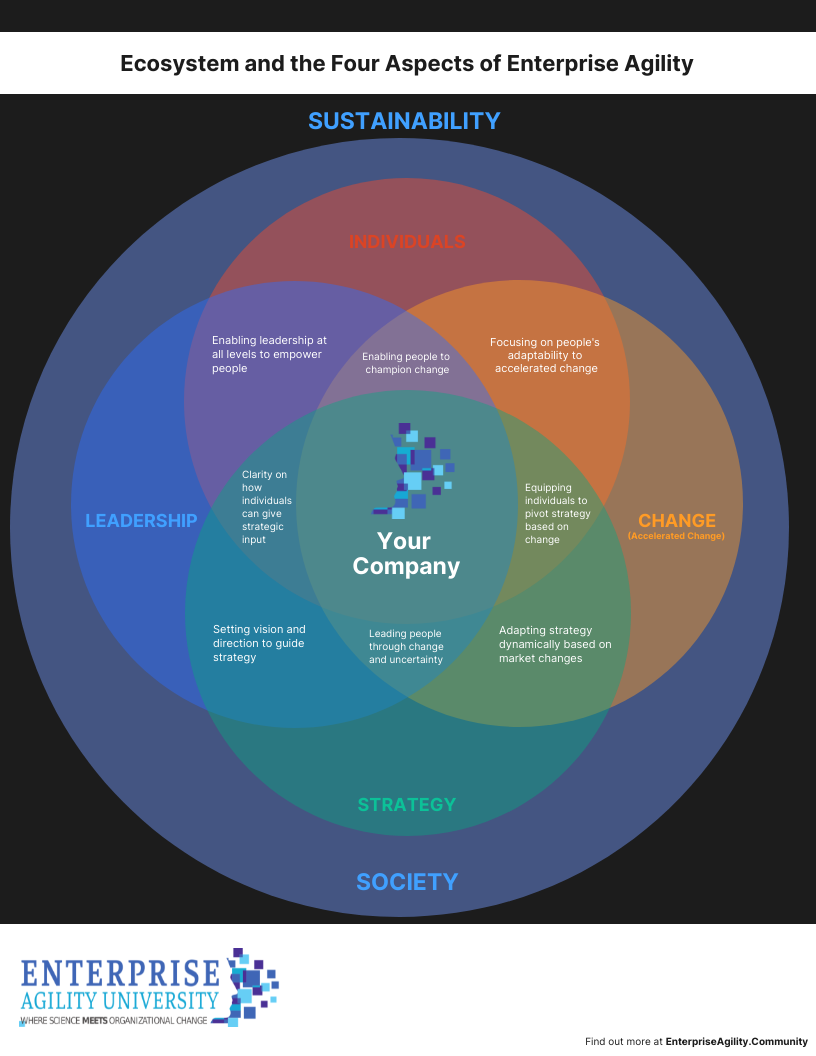Enterprise agility is a holistic ecosystem. Many have asked us to explain how our approach differs from traditional agile frameworks. EA ecosystem cultivates flexibility, resilience, and sustainability across multiple domains, not only in the company or products but also in society.

We cultivate the Enterprise Agility Way of Thinking (EAWT) to help organizations adapt quickly to change. This allows them to pivot quickly in the face of disruption while maintaining alignment and motivating employees. The EAWT approach enables sustainable, resilient responses to turbulence.
This ecosystem transforms enterprises into organisms that can rapidly adapt and thrive amid turbulence. Read on as we unpack the key differences between agile frameworks and our organic, whole-system view of Enterprise Agility.
At its core, Enterprise Agility encompasses a variety of models, frameworks, and approaches that help organizations and individuals succeed in an era of constant change and disruption. It goes well beyond the scope of traditional agile frameworks by considering four interconnected aspects:
- Individuals - This aspect focuses on the human dynamics, experiences, mindsets, and capabilities that people need to deal positively with accelerated change and exponential market shifts. It is about creating an environment that brings out the best in people and helps them quickly acquire new skills to adapt.
- Change - This aspect provides principles, processes, and models for deeply understanding change, building readiness for change, and shaping organizational responsiveness to disruption at all levels. It focuses on the Three universal outcomes—always ready, responsive, and innovative. It addresses the psychology and science of accelerated change to mobilize progress.
- Strategy - This aspect provides innovative approaches to opportunity discovery, planning, decision-making, and implementation appropriate for highly volatile conditions. It identifies ways to develop resilience while navigating through uncertainty.
- Leadership - This aspect includes next-generation leadership models, knowledge, and skills to empower groups in various stages of change and mobilize collective progress. The focus is on mobilizing leadership.
As you can see, the Enterprise Agility ecosystem is based on the science of accelerated change, which provides a solid knowledge base with three sections:
- Behavioral science - It examines human behaviors, motivations, biases, models of collaboration, and the contextual factors that drive change. It provides the psychological lens.
- Strategic mobility - This area of social science examines how diverse groups can be mobilizes and aligned with a new strategy in times of profound, accelerating change and uncertainty.
- Neuroscience of Change - This examines the biological pathways, dynamics, and effects of change on the brain. It is about how to drive change in a sustainable way.
The entire ecosystem of enterprise agility is focused on optimizing shared progress of customers, company, workforce wellbeing, partners and society—not just software or product delivery. It takes a comprehensive, forward-thinking perspective focused on creating sustainable value for society in the long run.

Rather than focusing on software, products, or profit, it considers the larger interdependent ecosystem and how actions positively impact communities, partners, the environment, and other stakeholders. Enterprise Agility utilizes foresight tools such as Future Thinking to evaluate how societal and global trends may evolve over time, enabling more informed decisions.
Frameworks like the TriValue Company model also come into play, promoting balanced value across customers, the organization, and employees by using the Social and Planet metrics in Spot indicators.
It also uses Future Thinking to allow a future-oriented mindset beyond just short-term goals. There is great emphasis on nurturing human potential, wellbeing, and capabilities to build an engaged society for tomorrow.
Principles of equity, diversity and inclusion (accelerated change principles #5 and #6, Enterprise Agility Fundamentals) help remove barriers and expand access, enabling responsible growth.
A mobilizing leadership aims to leave conditions better for the future while leveraging technology responsibly drives innovation that solves pressing issues.
Change is guided by shared progress, which activates our higher human motivations beyond profits. In this way, Enterprise Agility integrates social responsibility and preparedness into its very fabric. It transforms organizations into change leaders that uplift their entire ecosystem both now and for the long-term.
SAFE and Scrum Frameworks
In contrast, frameworks like Scrum and SAFe primarily optimize software or product development and business outcomes. While Scrum and SAFe have their merits in their respective application areas, Enterprise Agility complements their strengths by providing the overall context to drive progress on a broader scale. The science-based ecosystem approach and its focus on Planet and Society, help transform the entire business models or industries while benefiting society.
Combining the universal perspective of Enterprise Agility with targeted frameworks such as Scrum and SAFe enables organizations to build comprehensive systems that fully engage teams, partners, and communities. This fosters greater flexibility to not only deliver products, but to reshape the future for the benefit of all stakeholders.
In summary, enterprise agility is a science-based comprehensive ecosystem that empowers organizations to identify opportunities in uncertainty and thrive amid accelerating change for the benefit of society. It goes beyond individual frameworks by integrating diverse perspectives, such as planet, society, and sustainability, into an adaptive, resilient whole focused on shared progress.
Why We Need an Ecosystem?
As you have seen, Enterprise Agility provides a multi-layered ecosystem that enables organizations to navigate exponential change and disruption. With science-based models that incorporate multiple perspectives, companies are able to respond quickly when volatile conditions require adaptation.
However, software or product agility is only part of the formula for being successful today. We must also broaden our view beyond immediate business concerns and consider the larger context of the planet, society, and our shared future and future.
In a world of ever-increasing complexity and acceleration, actions in interconnected systems impact us in ways we can't always predict. Resources once taken for granted are being depleted in unsustainable ways. Social inequality deepens dangerous divides. Short-term thinking threatens long-term viability.
This makes it extremely important that we responsibly manage our world and responsibly deal with our problems. Enterprise Agility encourages us to bravely look ahead and use change to advance humanity. It challenges us to protect precious natural resources through new ideas and technology. And to make sure technology has strong moral values that improve society.
By integrating social responsibility and sustainability into our change approaches, we fulfill the true promise of Enterprise Agility—shared prosperity and progress on a healthy planet. We lay the foundation for peace and progress for generations to come. This is the calling of our accelerated age. Progress without conscience is no progress at all and shared progress is the solution.
